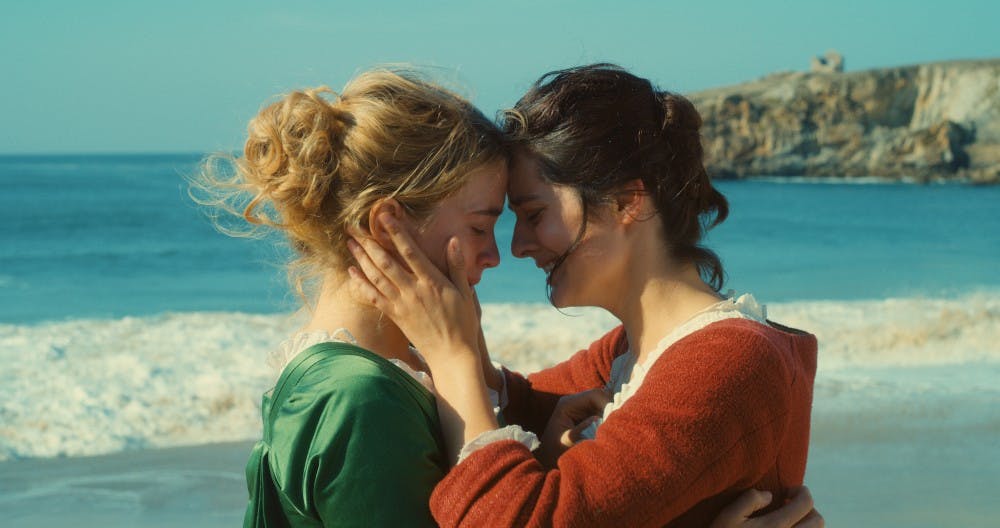“Non possum fugere.”
These are the haunting lyrics repeated again and again in one of the only moments of vibrant sound in Céline Sciamma’s latest film, “Portrait of a Lady on Fire,” which was screened Friday at Culbreth Theatre as part of the Virginia Film Festival. They are sung by a horde of women dancing and clapping around a fire, while the film’s two protagonists, Marianne and Héloïse watch each other from across the flames. The translation from Latin is “I cannot flee.” If there is one thing the viewer cannot do upon watching this film, it is escape its grasp — the effortless depiction of the female gaze and the heart wrenching nature of the valleys of womanhood in both the 18th and 21st centuries.
Escaping this modern masterpiece is not a possibility, but escaping the male gaze — for two hours — is. Apart from one nameless man responsible for transporting the protagonists from the coast of Brittany, France to Milan or Paris, the cast is entirely female. Sciamma allows for 121 minutes of freedom in intimacy without hypersexualization, and the depiction of a queer female romance without the performative nature that straight male directors often collapse into.
Héloïse, fresh from the Benedictines — the convent — has returned to her mother’s Brittany mansion in order to be painted for her Milanese suitor following the mysterious circumstances of her sister’s death. Marianne is there to paint her, even if “through it [she will be giving Héloïse] to another.”
Like most classic stories, we know the ending of “Portrait of a Lady on Fire.” We are told in the first scene at Marianne’s art school, that it is not a happy ending. Later on, as Héloïse reads the tale of Orpheus and Eurydice aloud in one scene, we again are reminded of the story’s end. It is a fate we cannot flee from. The question is how we will get there. This is 18th century France. This is a wealthy woman expected to behave a certain way. This is a fate written under a patriarchal society’s pressure and cues. We know that the love we root for will not last, and that we cannot evade the tight-knit nature of romance and tragedy.
Throughout all of history it is not the ending of a famous story that matters, but the process by which we get to it. Sciamma makes it clear in her soon-to-be iconic film, aligning her story with the tragedy of Orpheus and Eurydice, that this is a love story of tragic “almosts.” We know that Marianne and Héloïse could never truly end up together, but still torture ourselves with the question — what if they did?
These moments of blissful and tragic hope are what drive the film and its plot, but what makes the film are the details. Each frame may as well be a portrait itself. There are only three moments of music in the entire 121 minutes, all other sounds are made up of the intimate brush of a hand across dress fabric, the crackling of a fire, the ocean against the rocks or Marianne’s brushstrokes. Rather than head-on shots of the beautiful leading women, there are slow and calculated moments with their profiles, their backs, their hangnails and wispy hair. The last long and lingering shot of the film seemed to leave the entire audience breathless and in tears.
Sciamma manages to create a film that portrays a female tragedy without displaying an abundance of female trauma. She shows the ramifications of the male gaze and a patriarchal society through the tender opposition of a woman’s eye. Adèle Haenel and Noémie Merlant’s performances as Héloïse and Marianne are as healing as they are heartbreaking.
It is impossible to escape Sciamma’s new classic — it sticks to the viewer. With every brushstroke against canvas, or tender caress of Héloïse and Marianne’s hands, one is pulled deeper into a story that is worth telling again.
“Do all lovers feel as if they are inventing something new?” Héloïse asks towards the end of the film, and in doing so forces the audience to remember that while fresh and fulfilling — this romance is not new. Queer women do not just exist today, they existed in 18th century France, and long before that too, and will exist long after any of us today. They do not exist solely to be sexualized. Queer women exist for themselves and for each other — not for anyone to fetishize or traumatize. Sciamma makes sure this is clear and its resonance will not escape her audience.
“Portrait of a Lady on Fire” is iconic for its classic nature, and we will hear it again. We will not flee from it, not even if we wanted to.
The 2019 winner of Best Screenplay and the Queer Palm at Cannes will release broadly on Dec. 6.







